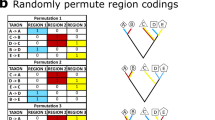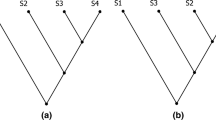Abstract
Analyzing morphological characters in a phylogenetic context comprises two steps, character analysis and cladistic analysis, which are equivalent to two independent tests for hypotheses on homology. The concept of homology concerns, comparable parts of the same or different organisms if their correspondences are the consequence of the same genetic or epigenetic information, and consequently of the same origin. The concept of homology is more inclusive than the character concept. Characters are seen as parts of transformation series. In the first step of morphological character analyses correspondences and non-correspondences between two characters are analyzed. A range of different examination methods and accurate study contribute to the severity of test. The hypothesis that two characters are homologous is corroborated if the correspondences outweigh the non-correspondences because the non-correspondences contradict the homology hypothesis whereas the correspondences contradict the analogy hypothesis. Complex characters, possess a higher empirical content than less complex characters because they are more severely testable. The cladistic analysis tests characters against other characters which have all passed the first test. Characters which are congruent with the most parsimonious topology are further corroborated; incongruent characters are not seen as ‘falsified’ but as not further corroborated and subject to reanalysis. To test both homologies and topologies repeatedly is consistent with Popperian testability, and it is in such cycles of research that hypotheses will be critically re-evaluated.
Similar content being viewed by others
References
Ax, P., 1988. Systematik in der Biologie. UTB 1502. Gustav Fischer, Stuttgart.
Bechly, G., 2000. Mainstream cladistics versus Hennigian phylogenetic systematics. Stuttgarter Beitr. Naturk. Ser. A 613, 1–11.
Bock, W.J., 1989. The homology concept: its philosophical foundation and practical methodology. Zool. Beitr. N.F. 32, 327–353.
Brower, A.V.Z., Schawaroch, V., 1996. Three steps of homology assessment. Cladistics 12, 265–272.
Bryant, H.N., 1989. An evaluation of cladistic and character analyses as hypothetico-deductive procedures, and the consequences for character weighting. Syst. Zool. 38, 214–227.
De Pinna, M., 1991. Concepts and tests of homology in the cladistic paradigm. Cladistics 7, 367–394.
Desutter-Grandcolas, L., Legendre, F., Grandcolas, P., Robillard, T., Murienne, J., 2005. Convergence and parallelism: is a new life ahead of old concepts? Cladistics 21, 51–61.
Dohle, W., 1989. Zur Frage der Homologie ontogenetischer Muster. Zool. Beitr. N.F. 32, 355–389.
Farris, J.S., 1983. The logical basis of phylogenetic analysis. In: Platnick, N.I., Funk, V.A., (Eds.), Advances in Cladistics: Proceedings of the Second Meeting of the Willi Hennig Society, vol. 2. Columbia University Press, New York, pp. 7–36.
Farris, J.S., 1995. Conjectures and refutations. Cladistics 11, 105–118.
Freudenstein, J.V., Pickett, K.M., Simmons, M.P., Wenzel, J.W., 2003. From basepairs to birdsongs: phylogenetic data in the age of genomics. Cladistics 19, 333–347.
Ghiselin, M.T., 1969. The distinction between similarity and homology. Syst. Zool. 18, 148–149.
Ghiselin, M.T., 2005. Homology as a relation of correspondence between parts of individuals. Theory in Biosciences 124, 91–103.
Grant, T., Kluge, A.G., 2004. Transformation series as ideographic character concept. Cladistics 20, 23–31.
Haszprunar, G., 1998. Parsimony, analysis as a specific kind of homology estimation and the implications for character weighting. Mol. Phyl. Evol. 9, 333–339.
Hawkins, J.A., Hughes, C.E., Scotland, R.W., 1997. Primary homology assessment characters and character states. Cladistics 13, 275–283.
Hennig, W., 1943. Ein Beitrag zum Problem der «Beziehungen zwischen Larven- und Imaginalsystematik». Arb. morphol. taxon. Ent. 10, 138–144.
Hennig, W., 1950. Grundzüge einer Theorie der phylogenetischen Systematik. Deutscher Zentralverlag, Berlin.
Hennig, W., 1966. Phylogenetic Systematics. University of Illinois Press, Urbana.
Hennig, W., 1984. Aufgaben und Probleme Stammesgeschichtlicher Forschung. Parey, Berlin.
Jardine, N., 1969. The observational and theoretical components of homology: a study based on the morphology of the dermal skull-roofs of rhipidistian fishes. Biol. J. Linn. Soc. London 1, 327–361.
Jenner, R.A., 2004a. Towards a phylogeny of the Metazoa: evaluating alternative phylogenetic positions of Platyhelminthes, Nemertea, and Gnathostomulida, with a critical reappraisal of cladistic characters. Contr. Zool. 73, 3–163.
Jenner, R.A., 2004b. Accepting partnership by submission? Morphological phylogenetics in a molecular millennium. Syst. Biol. 53, 333–342.
Kluge, A.G., 1977. Concepts and principles of morphologic and functional studies. In: Kluge, A.G. (Ed.), Chordate Structure and Function. Collier Macmillan, London, pp. 1–27.
Kluge, A.G., 1989. A concern for evidence and a phylogenetic hypothesis of relationships amongEpicrates (Boidae, Serpentes). Syst. Zool. 38, 7–25.
Kluge, A.G., 1997a. Testability and the refutation and corroboration of cladistic hypotheses. Cladistics 13, 81–96.
Kluge, A.G., 1997b. Sophisticated falsification and research cycles: consequences for differential character weighting in phylogenetic systematics. Zool. Scr. 26, 349–360.
Kluge, A.G., 1999. The science of phylogenetic systematics: explanations, prediction, and test. Cladistics 15, 429–436.
Kluge, A.G., 2001. Philosophical conjectures and their refutation. Syst. Biol. 50, 322–330.
Kluge, A.G., 2003. The repugnant and the mature in phylogenetic inference: atemporal similarity and historical identity. Cladistics 19, 356–368.
Lakatos, I., 1993. Falsification and the methodology of scientific research programmes. In: Lakatos, I., Musgrave, A. (Eds.), Criticism and the Growth of Knowledge. Cambridge University Press, London, pp. 91–196.
Meier, R., 1994. On the inappropriateness of presence/absence recoding for non-additive multistate characters in computerized cladistic analyses. Zool. Anz. 232, 201–212.
Neff, N.A., 1986. A rational basis for a priori character weighting. Syst. Zool. 35, 110–123.
Oakley, T.H., 2003. On homology of arthropod eyes. Integr. Comp. Biol. 43, 522–530.
Oakley, T.H., Cunningham, C.W., 2002. Molecular phylogenetic evidence for the independent evolutionary origin of an arthropod compound eye. PNAS 99, 1426–1430.
Osche, G., 1973. Das Homologisieren als eine grundlegende Methode der Phylogenetik. Aufs. Red. Senckenb. Nauturf. Ges. 24, 155–165.
Patterson, C., 1982. Morphological characters and homology. In: Joysey, K.A., Friday, A.E. (Eds.), Problems of Phylogenetic Reconstructions. Academic Press, London, New York, pp. 21–74.
Patterson, C., 1988. Homology in classical and molecular biology. Mol. Biol. Evol. 5, 603–625.
Platnick, N.I., 1979. Philosophy and the transformation of cladistics. Syst. Zool. 28, 537–546.
Pleijel, F., 1995. On character coding for phylogeny reconstruction. Cladistics 11, 309–315.
Poe, S., Wiens, J.J., 2000. Character selection and the methodology of morphological phylogenetic. In: Wiens, J.J. (Ed.), Phylogenetic Analysis of Morphological Data. Smithsonian Institution. Washington, DC, pp. 20–36.
Popper, K.R., 1983, Realism and the Aim of Science. Routledge, London.
Popper, K.R., 1994. Logik der Forschung. Zehnte, verbesserte und vermehrte Auflage. Mohr, Tübingen.
Remane, A., 1952. Die Grundlagen des natürlichen Systems, der vergleichenden Anatomie und der Phylogenetik. Akademische Verlagsgesellschaft, Leipzig.
Riedl, R., 1975. Die Ordnung des Lebendigen. Parey, Hamburg.
Riedl, R., 2000. Strukturen der Komplexität. Eine Morphologie des Erkennens und Erklärens. Springer, Berlin.
Rieppel, O., 1988. Fundamentals of Comparative Biology. Birkhäuser, Basel.
Rieppel, O., 2003. Popper and systematics Syst. Biol. 52, 259–271.
Rieppel, O., 2004. What happens when the language of sicnece threatens to break down in systematics: a Popperian approach. In: William, D.M., Forey, P.L. (Eds.), Milestones in Systematics. CRC Press, Boca Raton, FL, pp. 57–100.
Rieppel, O., Kearney, M., 2002. Similarity. Biol. J. Linn. Soc. 75, 59–82.
Schmitt, M., 1995. The homology concept—still alive. In: Breidbach, O., Kutsch, W. (Eds.), The Nervous System of Invertebrates: An Evolutionary and Comparative Approach. Birkhäuser, Basel, pp. 425–438.
Scholtz, G., 2005. Homology and Ontogeny: pattern and process in comparative developmental biology. Theory in Biosciences 124, 121–143.
Scotland, R.W., Olmstead, R.G., Bennett, J.R., 2003. Phylogeny reconstruction: the role of morphology. Syst. Biol. 52: 539–548.
Siddall, M.E., Kluge, A.G., 1997. Probabilism and phylogenetic inference. Cladistics 13, 313–336.
Strong, E.E., Lipscomb, D., 1999. Character coding and inapplicable data Cladistics 15, 363–371.
Sudhaus, W., Rehfeld, K., 1992. Einführung in die Phylogenetik und Systematik. Gustav Fischer, Stuttgart.
Van Valen, L.M., 1982. Homology and causes. J. Morphol. 173, 305–312.
Wägele, J.-W., 2000. Grundlagen der Phylogenetischen Systematik. Pfeil, München.
Wägele, J.-W., 2004. Henning’s phylogenetic systematics brought up to date. In: William, D.M., Forey, P.L. (Eds.), Milestones in Systematics. CRC Press, Boca Raton, FL, pp. 101–126.
Wagner, G.P., 2001. Characters, units and natural kinds: an introduction. In: Wagner, G.P. (Ed.), The Character Concept in Evolutionary Biology. Academic Press, San Diego, pp. 1–10.
Wheeler, W.C., 1996. Optimization alignment: the end of multiple sequence alignment in phylogenetics? Cladistics 12, 1–9.
Wheeler, W.C., 2001. Homology and DNA sequence data. In: Wagner, G.P. (Ed.), The Character Concept in Evolutionary Biology. Academic Press, San Diego, pp. 303–317.
Whiting, M.F., Bradler, S., Maxwell, T., 2003. Loss and recovery of wings in stick insects. Nature 421, 264–267.
Wiley, E.O., 1981. Phylogenetics. The Theory and Practice of Phylogenetic Systematics. Wiley-Liss, New York.
Author information
Authors and Affiliations
Corresponding author
Additional information
From the 46th “Phylogenetisches Symposium”, Jena, Germany, November 20–21, 2004. Theme of the symposium: “Evolutionary developmental biology—new challenges to the homology concept?”.
Rights and permissions
About this article
Cite this article
Richter, S. Homologies in phylogenetic analyses—concept and tests. Theory Biosci. 124, 105–120 (2005). https://doi.org/10.1007/BF02814479
Received:
Accepted:
Issue Date:
DOI: https://doi.org/10.1007/BF02814479




